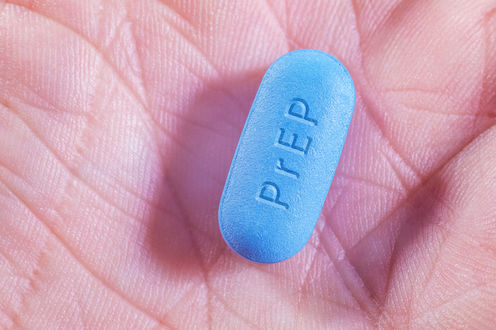
Pre-exposure prophylaxis, or PrEP, is the administration of antiviral drugs to a person not infected with HIV to prevent infection.
The only licensed version of PrEP is a daily oral tablet called Truvada®, which contains a combination of two antiretroviral drugs: tenofovir disoproxil fumarate (300mg) and emtricitabine (200mg).
Other strategies for delivery are being developed, including injections and topical applications with vaginal rings or gels. Other antivirals are also being tested for PrEP, but here we’ll focus on Truvada.

History of PrEP
Antiretroviral therapy was first introduced as a life-saving treatment for people with HIV in 1996. Researchers then tested antiretrovirals similar to Truvada on monkey models to see if they could prevent infection with simian immunodeficiency virus, the monkey equivalent of HIV. They were successful.
The first large clinical trial to show PrEP was effective in humans, iPrEX, compared daily Truvada to a placebo, or a sugar tablet, in men who have sex with men. The trial, which ran from 2007 to 2009, showed overall efficacy of 44%. This means the HIV infection rate in gay men who were given the pill was reduced by 44% compared to men who were given the placebo.
Efficacy rates increased to more than 92% in participants who had detectable levels of Truvada in their blood, indicating they adhered to the strict daily treatment regimen.
Subsequent trials have shown similar efficacy of more than 86% using event-driven PrEP in men who have sex with men. This means taking the drug prior to and following sex. Among people who inject drugs, daily PrEP had an efficacy rate of 50%.
Clinical trials in heterosexual women of both oral and topical PrEP have had mixed findings, with some studies being stopped early due to no evidence of benefit. But women in these studies were often not taking the medication. In other studies of heterosexual women, PrEP reduced HIV transmission by up to 76%.
All studies have clearly demonstrated that efficacy was directly related to adherence. Users benefited only if they consistently took the medications or consistently used topical PrEP.
Efficacy is estimated to be as high as 99% in men who have sex with men who take Truvada daily.
Availability
PrEP was licensed in the US in 2012 and was registered by the Therapeutic Goods Administration in Australia in May 2016. The Pharmaceutical Benefits Advisory Committee is evaluating whether PrEP will be listed and subsidised on the Pharmaceutical Benefits Scheme.
Newer forms of PrEP being evaluated include injections of antivirals such as cabotegravir, as well as topical administration of antivirals, including the vaginal ring containing the antiviral dapivirine and monoclonal antibodies.
Monoclonal antibodies are not drugs but they can bind to a virus and eliminate the capacity for the virus to infect a cell.
None of these strategies are currently licensed.
How it works
PrEP works by preventing susceptible cells becoming infected with HIV. Truvada blocks the HIV virus from making copies of itself.
When starting PrEP, it takes at least seven days to reach high levels of protection against HIV for men who have sex with men and also for women.
When stopping PrEP, people should continue using PrEP for four weeks after the last significant exposure.
It’s important to note that PrEP doesn’t protect against other sexually transmitted infections (STI) or pregnancy.
Truvada is, however, also active against hepatitis B virus and may have some activity against the herpes simplex virus too.
Problems and controversies
Although scientists demonstrated the efficacy of PrEP in 2010, it has taken several years for this preventative measure to be used in clinical practice. The main controversy has been related to cost and who pays.
Concerns have also been raised about a reduction in safer sex, but the majority of studies have not shown a decrease in condom use, or an increase in STIs. But even in the context of increased STIs, the benefit in PrEP reducing new HIV infections is clear.
Side effects
The main side-effects of Truvada are gastrointestinal. These tend to diminish after the first few months of PrEP. It occasionally causes headaches and fatigue.
Regular screening of kidney function is performed for people receiving PrEP as the drug can impair kidney function. But this is reversible. Very rarely, PrEP can lead to more severe kidney dysfunction.
Some bone thinning has been reported, but this is also reversible.
Cost
The cost of PrEP depends on the source of supply. In Australia, Truvada can be purchased from the manufacturer, Gilead, and costs A$750 per month.
Generic forms are available from overseas manufacturers, which may cost A$158 per month, or more. Having a valid Australian prescription, completed by a registered medical practitioner and completing all the paperwork will facilitate the process for delivery.
Some state governments are running large studies to demonstrate the effectiveness of PrEP. In these studies, medication is free except in Victoria.
The authors acknowledge helpful discussions and contributions from Mr Bill Whittaker, National Association of People Living with HIV in Australia.
Sharon Lewin receives funding from the NHMRC, the National Institutes for Health, Wellcome Trust, American Foundation of AIDS research, the University of Malaya, the Danish Medical Council, the Australian Centre for HIV and Hepatitis and investigator-initiated company funded studies from Merck, Gilead and ViiV. She is a member of the International AIDS Society.
Edwina Wright receives funding from a research grant from NIH, a Career Development Fellowship from the National Health and Medical Research Council of Australia, research funding from the Victorian Department of Health and unrestricted research funds from Gilead, Abbott, Janssen Cilag and Boehringer Ingelheim. She has also received funding that has been used for research purposes only from ViiV, Merck, Gilead, and Abbott for consultancy work, payment for lectures from ViiV and payment for developing educational resources for ViiV and Gilead. The study drug for the VicPrEP study has been donated by Gilead Sciences.
